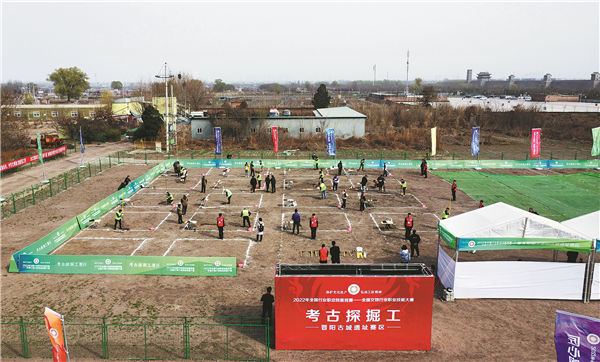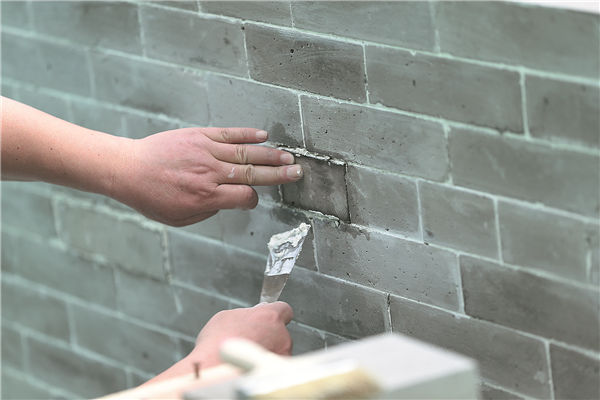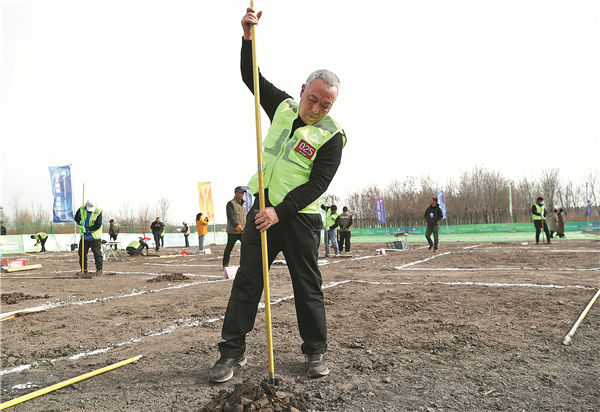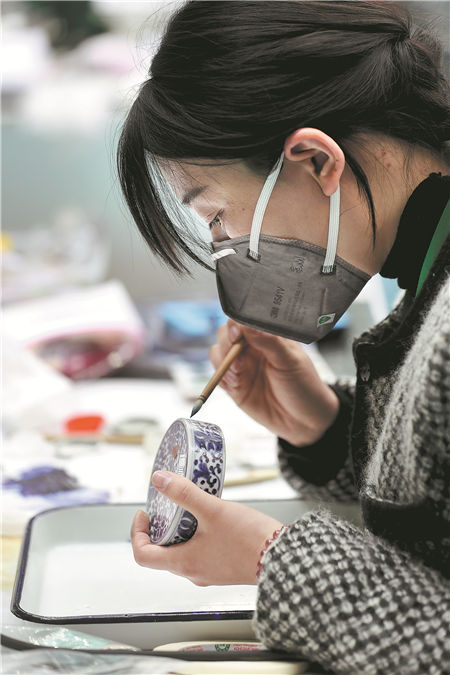Digging up the past to help the future
Updated: 2023-04-11

A competition in March to measure skills of archaeological excavation, part of the National Vocational Skills Competition on Cultural Relics, is underway in Taiyuan, Shanxi province. [Photo by Zou Hong/China Daily]
Archaeologists endure backbreaking work and long hours but every now and then they find something to make their efforts worthwhile, Wang Ru and Sun Ruisheng report in Taiyuan.
Li Lei remembers his first experience with an archaeological exploration in 2007, when he was still an undergraduate working as an intern for a project in Zhangjiakou, Hebei province. After being shown soil coring skills, inserting a Luoyang shovel (curved spade) into the ground and then extracting it to see the layers, he tried to copy it by using the shovel to dig up earth. The hole he excavated was much wider than normal, which caused people standing nearby to laugh.
After years of working in field archaeology, Li, 38, who now works at Hebei Provincial Institute of Cultural Relics and Archaeology, could confidently display his full range of skills at the National Vocational Skills Competition on Cultural Relics held in Taiyuan, Shanxi province, in March.
Organized by the National Cultural Heritage Administration, Ministry of Human Resources and Social Security and All-China Federation of Trade Unions, the event held competitions on archaeological exploration skills, restoring wooden cultural relics, tiles and brickwork, porcelain and pottery, murals and bronze ware.
"Restoring cultural relics is about craftsmanship. But I guess nobody has a deeper understanding of the newly unearthed artifacts than us, who are engaged with field archaeology," says Li.
The competition on archaeological exploration skills measures a competitor's coring skill, which is part of the archaeological survey usually conducted before excavations to provide reference for further digging.
According to Hai Jinle, former deputy director of the Shanxi Provincial Institute of Cultural Relics and Archaeology, who worked as a judge for the competition, archaeological survey usually involves studying the terrain to observe the condition of the land and then select areas for coring.
From the stratigraphic perspective, strata are deposited in a chronological order, with the oldest layer at the bottom. Human activity impacts layers, making them very different from each other in color and texture of the soil and its inclusion. As a result, by coring, people can discover archaeologically interesting layers and identify their time, says Hai.

A competitor works on restoring a tile and brickwork. [Photo by Zou Hong/China Daily]
The work is done by swinging a Luoyang shovel, a semicylindrical ironware with an extended rod, as a traditional tool used for archaeological work in China, to dig into the ground and lift the soil sample out. By observing it, one can judge the time of each layer, and form a picture of what occurred in the given place over a period of time. Usually they dig the hole until they reach the natural layer with no evidence of human impact on the environment.
After the procedures, archaeologists can gain a basic understanding of the size, depth, range and type of a site, and have statistics for possible later excavation, according to Li.
The work must be done carefully, or it may disrupt follow-up work. According to Zhang Wentao, who has worked on archaeological exploration for a company in Yinchuan, Ningxia Hui autonomous region, for 13 years, if the initial data of a site is wrongly recorded, it can increase the excavation workload. There are a number of techniques required in the process. For example, archaeologists need to consider how to gain enough information by punching as few test holes as possible.
"Coring causes unavoidable harm to the underground remains. That's why we try to gain information of the underground remains with as few holes as possible," says Li. "Moreover, for different types of sites, the ways of distributing holes are different."
Another difficult point lies in observing the soil to judge the time of layers, since it varies in different places.
"China's archaeological excavation skills have been mainly learned from Western countries, but the coring skill with a Luoyang shovel is our own. It is full of Chinese characteristics," says Qiao Liang, a researcher at China Academy of Cultural Heritage, who worked as chief of judges for the competition.

Veteran technician Niu Xiuping shows his coring skills at the competition. [Photo by Zou Hong/China Daily]
According to Hai, in foreign countries, this step is mainly accomplished by machines, and the difference in methods is related to the different situations of layer deposit between East Asian and Western countries.
Although technology has been applied for this work in China as well, it cannot replace manpower as of now. "In China, conducting archaeological exploration with Luoyang shovel is still the most time-consuming and labor-consuming method," says Hai.
"At first, the work was really tiring for me," says Zhang, 35.
He learned the coring technique from senior workers in Shouxian county, Anhui province, for a year, going to the field every day to listen to their teaching and trying by himself. Although he wore gloves at work, he soon had blisters in his hands, which later turned to calluses.
"I didn't want to show my hands to others at that time," recalls Zhang, who couldn't identify the layers at first, but mastered the skills after about four to five years.
His work brings rewards.
"My satisfaction came when our exploration work finished. People excavated the site and discovered that the result of our exploration was close to their final conclusion. It means our work could really provide a reference for them," says Zhang.
For veteran technician Niu Xiuping, 60, who has been devoted to field archaeological projects at the Shanxi Provincial Institute of Cultural Relics and Archaeology for nearly 40 years and is about to retire in June, field archaeology is "quite interesting, but boring as well".
Repetition can lead to boredom. But when they discover something, everyone is amazed.

Li Tong tests her skills in the porcelain and pottery restoration section of the competition. [Photo by Zou Hong/China Daily]
He has taken part in a number of important discoveries, like the Gaohong site in Liulin county, Shanxi, Hengshui Western Zhou Dynasty (c. 11th century-771 BC) grave complex in Yuncheng, Shanxi, and the Shizitan Paleolithic site in Jixian county, Shanxi. All were on the list of China's top 10 new archaeological discoveries, an annual compilation often referred to as the "Oscars of Chinese archaeology".
Niu won second prize in the competition. He has received a reemployment request after retirement from where he works, and is ready to continue his work for another five years.
Recalling his past years, Niu says, "The work is good for me. There are so many impressive moments in doing archaeological work. It seems I blinked my eyes and in an instant, decades had passed."
Li grew an interest in archaeology as a middle school student, and this led him to work as a volunteer and an intern in the archaeological field when he was a computer major at the University of Electronic Science and Technology of China in Chengdu, Sichuan province. In 2013, he was recruited by the Hebei Provincial Institute of Cultural Relics and Archaeology, and officially began his archaeological career.
His interest has been kept since he is able to decode the past through his work. "For example, when we excavate a tomb, we can know their burial rituals, customs of their lives and even their races and how they migrated in the ancient time. Historical records reveal some things, although they are not always accurate," says Li.
He has applied computer technology, like three-dimensional modeling, to field archaeology, which can make it more precise." By borrowing methods from many other subjects, archaeology is increasingly multidisciplinary and precise, but field archaeology is the basis of that," says Li.
Now, he spends more than 300 days a year on average working outdoors with his colleagues. They rarely rest, even on weekends. Work is only disrupted by inclement weather.
"Archaeology is laborious. All of the well-known archaeologists in China, like Xia Nai, Su Bingqi, and Zou Heng, spent a great deal of time in the field. They worked like farmers in the fields, but the result of their research is outstanding in the world," says Hai.



